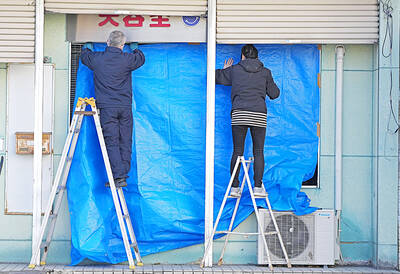The remaining Greyhound buses that are still in use are scheduled to cease operating on Thursday next week after being in service for 37 years, according to Kuo Kuang Motor Transportation Corp.
The freeway bus operator said that it would sell Greyhound bus tickets to people wanting to keep them as memorabilia. Meanwhile, two Greyhound buses are to go on display at its bus depot near the Taipei Railway Station. One of them is the first Greyhound bus in the nation, which was remodeled to carry 20 bicycles and 20 passengers. The other one is to be converted into an art gallery, showcasing various photographs of Greyhound buses taken over the past 37 years.
In addition, five Greyhound buses are to be used to carry people who wish to have one last ride on them. People must to reserve tickets for the bus tours, which are to travel between Taipei Railway Station and Dajia Riverside Park.
Company manager Wu Chung-si (吳忠錫) said that the National Sun Yat-Sen Freeway (National Freeway No. 1) was opened for traffic in 1978 and the Directorate General of Highways (DGH), which owned the company at the time, purchased 50 Greyhound buses from Des Plaines, Illinois-based Motor Coach Industries, Wu said.
Wu said Greyhound buses were renamed Kuo Kuang coaches, which literally means the “glory of the nation.” They were used to carry passengers from Taipei to Kaohsiung and were the main means of transportation connecting the north to the south due to limited rail transport capacity at the time, he said.
Wu said that the company had owned 480 Greyhound buses, adding that the coaches were not as fuel-efficient as other buses and are expensive to maintain.
“Other buses can run 3km to 4.5km on one liter of gasoline, but Greyhound buses can only run 1km per liter. We also had to import vehicle parts from the US, so maintenance costs of Greyhound buses were three to four times higher than those of other buses,” Wu said.
He said the company phased out the use of the buses, adding that the number of Greyhound buses was down to 300 by 2010.
Kuo Kuang coaches were known for employing female service attendants onboard.
A military affairs official claimed that the buses’ engines could be removed and reinstalled in military tanks, so when the nation severed official diplomatic ties with the US in 1979, the government bought more Greyhound buses to beef up supplies of back-up engines for tanks.
Wu said that the number of the Greyhound buses dwindled to 33 last year. Fourteen are still being used to carry passengers between Taipei and Taiwan Taoyuan International Airport.
He said that the company would keep five buses to provide tours for bus fans, while others would be donated to the DGH for public display. The rest would be sold, Wu said, adding that the body of a Greyhound bus is worth NT$600,000 to NT$700,000.

Taiwanese were praised for their composure after a video filmed by Taiwanese tourists capturing the moment a magnitude 7.5 earthquake struck Japan’s Aomori Prefecture went viral on social media. The video shows a hotel room shaking violently amid Monday’s quake, with objects falling to the ground. Two Taiwanese began filming with their mobile phones, while two others held the sides of a TV to prevent it from falling. When the shaking stopped, the pair calmly took down the TV and laid it flat on a tatami mat, the video shows. The video also captured the group talking about the safety of their companions bathing

US climber Alex Honnold is to attempt to scale Taipei 101 without a rope and harness in a live Netflix special on Jan. 24, the streaming platform announced on Wednesday. Accounting for the time difference, the two-hour broadcast of Honnold’s climb, called Skyscraper Live, is to air on Jan. 23 in the US, Netflix said in a statement. Honnold, 40, was the first person ever to free solo climb the 900m El Capitan rock formation in Yosemite National Park — a feat that was recorded and later made into the 2018 documentary film Free Solo. Netflix previewed Skyscraper Live in October, after videos

Starting on Jan. 1, YouBike riders must have insurance to use the service, and a six-month trial of NT$5 coupons under certain conditions would be implemented to balance bike shortages, a joint statement from transportation departments across Taipei, New Taipei City and Taoyuan announced yesterday. The rental bike system operator said that coupons would be offered to riders to rent bikes from full stations, for riders who take out an electric-assisted bike from a full station, and for riders who return a bike to an empty station. All riders with YouBike accounts are automatically eligible for the program, and each membership account

A classified Pentagon-produced, multiyear assessment — the Overmatch brief — highlighted unreported Chinese capabilities to destroy US military assets and identified US supply chain choke points, painting a disturbing picture of waning US military might, a New York Times editorial published on Monday said. US Secretary of Defense Pete Hegseth’s comments in November last year that “we lose every time” in Pentagon-conducted war games pitting the US against China further highlighted the uncertainty about the US’ capability to intervene in the event of a Chinese invasion of Taiwan. “It shows the Pentagon’s overreliance on expensive, vulnerable weapons as adversaries field cheap, technologically